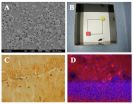Design of micro and nanoparticles to improve treatments for Alzheimer's and Parkinson's
At the Faculty of Pharmacy of the UPV/EHU-University of the Basque Country encapsulation techniques are being developed to deliver correctly and effectively certain drugs
2014-10-20
(Press-News.org) This news release is available in Spanish.
Enara Herran, a researcher at the UPV/EHU's Department of Pharmacy and Pharmaceutical Technology, is working to improve the way Alzheimer's and Parkinson's treatments are administered. And it is a fact that, as Herran herself stressed, "both diseases are becoming more and more common in our society".
Both disorders affect the neurones: their structure and function is lost, and this in turn leads to the deterioration in the patient's motor, cognitive, sensory and emotional functions. As Herran pointed out, in many cases the drugs used to treat both Alzheimer's and Parkinson's only mitigate the symptoms; they do not act on the origin of the disease. "The treatment is usually on the basis of tablets taken by mouth."
But drugs of this type are not the only ones used to tackle both Alzheimer's and Parkinson's. Some drugs prevent neuron loss and help new ones to form; growth factors, for example. "In any case, they are not used so much because there is no effective, safe way of delivering them," said Herran. As the researcher explained, the drugs have to pass through the blood-brain barrier to reach the neurons, and that is no straightforward task. This is in fact the problem Herran is seeking to overcome by means of her research.
"Growth factors are encapsulated so that they can be administered more effectively and more safely. In other words, they are inserted into micro and nanocapsules and implanted in the brain by means of craniotomy. That way, the drugs would be released right where they have to act, and what is more, in an ongoing way and in the correct dose," explained Herran.
The micro and nanoparticles release these growth factors within a period ranging from 2-3 months and one year until the polymer has degraded. That way the patient does not have to take the medication every day. In any case, this is not the only advantage. In experiments carried out on rats and mice the encapsulated drugs have been found to be much more effective than those taken by mouth. As Herran pointed out, "these two diseases are already a problem for public health, and the scientific community is making a great effort in the quest for and in advances in new treatments".
Heading in the right direction
As Herran explained, in experiments conducted on animals they have tested two factors —the vascular endothelial growth factor (VEGF) and the glial cell-line derived neurotrophic factor (GDNF)— encapsulated in a biocompatible, biodegradable polymer —poly (lactic co-glycolic acid) (PLGA)—. "We obtained micro and nanoparticles using various encapsulation techniques. Initially, we did the tests for Parkinson's; first in cell cultures and then on mice. We got good results in both trials." Herran stressed that the mice treated with particles improved considerably: "A great improvement was noted in comparison with the control group in terms of behaviour as well as the healing of the damaged zones."
After that, they carried out the test for Alzheimer's in mice. Herran said that in this case they also achieved good results: "Three months after having carried out the procedure, the mice treated had good memories; similar to those of healthy mice. Through a histological analysis we found that the beta-amyloid plaques that develop in Alzheimer's had diminished considerably and so had the inflammation, and that angiogenesis had intensified."
The results and conclusions of these experiments have been publicised in specialised publications including the renowned Journal of Controlled Release. And this is in fact the subject of her PhD thesis. Although the research has not been completed, Herran said she is now doing research into the way of obtaining "better formulations", so as not to have to implant the micro and nanoparticles in the brain. The final goal is clear: to develop the most effective, safest and most suitable way of treating Parkinson's and Alzheimer's.
INFORMATION:
Additional information
Enara Herran-Martínez (Vitoria-Gasteiz, 1985), a Doctor in Pharmacy, wrote up her PhD thesis on "Micro y nanopartículas de factores angiogénicos y neurotróficos como herramienta terapéutica para el tratamiento de enfermedades neurodegenerativas" (Micro and nanoparticles of angiogenic and neurotrophic factors as a therapeutic tool for treating neurodegenerative diseases), under the supervision of Prof Rosa María Hernández and Dr Manoli Igartua, of the UPV/EHU's Department of Pharmacy and Pharmaceutical Technology.
She produced her thesis mainly in the UPV/EHU's Department of Pharmacy and Pharmaceutical Technology, although part of it was done in the Neurosciences Laboratory at the research centre of the Hospital 12 de Octubre in Madrid.
In connection with her thesis she has had various papers published in scientific journals:
E. Herran, J.A. Ruis-Ortega, A. Aristieta, M. Igartua, C. Requejo, J.V. Lafuente, L. Ugedo, J.L. Pedraz, R.M. Hernandez. "In vivo administration of VEGF- and GDNF-releasing biodegradable polymeric microspheres in a severe lesion model of Parkinson's disease". European Journal of Pharmaceutics and Biopharmaceutics 85 - 3: 1183 - 1190 (2013).
E. Herran, R. Perez-Gonzalez, M. Igartua, J.L. Pedraz, E. Carro, R.M. Hernandez. "VEGF-releasing biodegradable nanospheres administered by craniotomy: A novel therapeutic approach in the APPPs1 mouse model of AD". Journal of Controlled Release 170: 111 - 119 (2013).
E. Herran, C. Requejo, J.A. Ruiz-Ortega, A. Aristieta, M. Igartua, H. Bengoetexea, L.Ugedo, J.V. Lafuente, R.M. Hernandez. "Increased antiparkinson efficacy of the combined administration of VEGF and GDNF-releasing nanospheres in a partial lesion model of Parkinson's disease". International Journal of Nanomedicine 9: 2677 - 2687 (2014).
E. Herran Martinez, M. Igartua Olaechea, J.L. Pedraz Muñoz, R.M. Hernández Martín. "Novel Drug Delivery Systems for Releasing Growth Factors to the CNS: Focus on Alzheimer's and Parkinson's Diseases". Mini-Reviews in Medicinal Chemistry 14 - 7: 557 - 566 (2014).
[Attachments] See images for this press release:

ELSE PRESS RELEASES FROM THIS DATE:
2014-10-20
VIDEO:
The Internet "sleeps " -- but not everywhere. Find out why.
Click here for more information.
Researchers studying how big the Internet is have found that it "sleeps," almost like a living creature.
The finding will help scientists and policymakers develop better systems to measure and track Internet outages, such as those that struck the New York area after Hurricane Sandy. Understanding how the Internet sleeps will help them avoid confusing a sleeping Internet with ...
2014-10-20
Fish just want to have fun, according to a University of Tennessee, Knoxville, study that finds even fish "play."
The research is published in the academic journal Ethology and can be viewed at http://bit.ly/1tLunpC.
Gordon Burghardt, a professor in the departments of Psychology and Ecology are Evolutionary Biology, is known for defining "play" in a way that allows us to identify it in species not previously thought capable of play, such as wasps, reptiles and invertebrates.
"Play is repeated behavior that is incompletely functional in the context or at the age ...
2014-10-20
This news release is available in German. Diatoms play an important role in water quality and in the global climate. They generate about one fourth of the oxygen in the Earth's atmosphere and perform around one-quarter of the global CO2 assimilation, i.e. they convert carbon dioxide into organic substances. Their light receptors are a crucial factor in this process. Researchers at the Leipzig University and the Helmholtz Centre for Environmental Research have now discovered that blue and red light sensing photoreceptors control the carbon flow in these algae. These ...
2014-10-20
WASHINGTON, DC – A mass of marine debris discovered in a giant sinkhole in the Hawaiian islands provides evidence that at least one mammoth tsunami, larger than any in Hawaii's recorded history, has struck the islands, and that a similar disaster could happen again, new research finds. Scientists are reporting that a wall of water up to nine meters (30 feet) high surged onto Hawaiian shores about 500 years ago. A 9.0-magnitude earthquake off the coast of the Aleutian Islands triggered the mighty wave, which left behind up to nine shipping containers worth of ocean ...
2014-10-20
Since World War II, more than 45 international human-rights treaties have been signed by many of the world's roughly 200 countries. But why do some states sign such accords, especially if they lack a strong human-rights commitment in the first place?
One prominent idea holds that treaty-ratifying countries are essentially bought off: They agree to lend support to the human-rights movement in exchange for material good, such as foreign aid or more trade. However, a new study co-authored by an MIT political scientist finds that not to be the case; the actions of states, ...
2014-10-20
This news release is available in German. What started out as a mathematical oddity, has now become a new kind of laser technology. Two years ago, physicists at TU Wien predicted a paradoxical laser effect: Under certain conditions, a laser can be switched on not by supplying it with more energy, but by taking energy away from the laser. First experimental signatures of this effect were recently reported at TU Wien. In collaboration with colleagues at Washington University in St. Louis, USA and at Riken, Japan the researchers have now succeeded in transferring the paradoxical ...
2014-10-20
Amsterdam, NL, October 20, 2014 – White Canes provide low-tech assistance to the visually impaired, but some blind people object to their use because they are cumbersome, fail to detect elevated obstacles, or require long training periods to master. Electronic travel aids (ETAs) have the potential to improve navigation for the blind, but early versions had disadvantages that limited widespread adoption. A new ETA, the "EyeCane," developed by a team of researchers at The Hebrew University of Jerusalem, expands the world of its users, allowing them to better estimate ...
2014-10-20
Climate change predictions for the Middle East, like other arid regions of the world, are alarming. In an area known for its water scarcity, rainfall is expected to decrease even further in the near future, spelling disaster for the functioning of unique ecosystems — hotspots of biodiversity and rich genetic fodder for essential crops.
To test these dire predictions, Prof. Marcelo Sternberg of the Department of Molecular Biology and Ecology of Plants at Tel Aviv University's Faculty of Life Sciences, together with ecologists from the University of Tübingen ...
2014-10-20
Older people from Pakistani and Bangladeshi communities in England fear changes in cultural attitudes will leave them without the family care they expect to rely on in their twilight years, a new study has found.
The research, undertaken at Brunel University London, reports that elderly people in these communities expect their children and wider family will look after them in old age and are traditionally unlikely to take-up state social services.
However, those surveyed also expressed uncertainty over whether changes in cultural attitudes and geographical factors ...
2014-10-20
Members of today's younger Net Generation aren't more tech savvy than their teachers just because they were born into a world full of computers. In fact, if it weren't for the coaxing and support of their educators, many students would never use their electronic devices for more than playing games or listening to music. So says Shiang-Kwei Wang of the New York Institute of Technology in the US, who led a study on how middle school science teachers and their students use technology inside and outside the classroom. The findings¹ appear in the journal Educational Technology ...
LAST 30 PRESS RELEASES:
[Press-News.org] Design of micro and nanoparticles to improve treatments for Alzheimer's and Parkinson's
At the Faculty of Pharmacy of the UPV/EHU-University of the Basque Country encapsulation techniques are being developed to deliver correctly and effectively certain drugs





